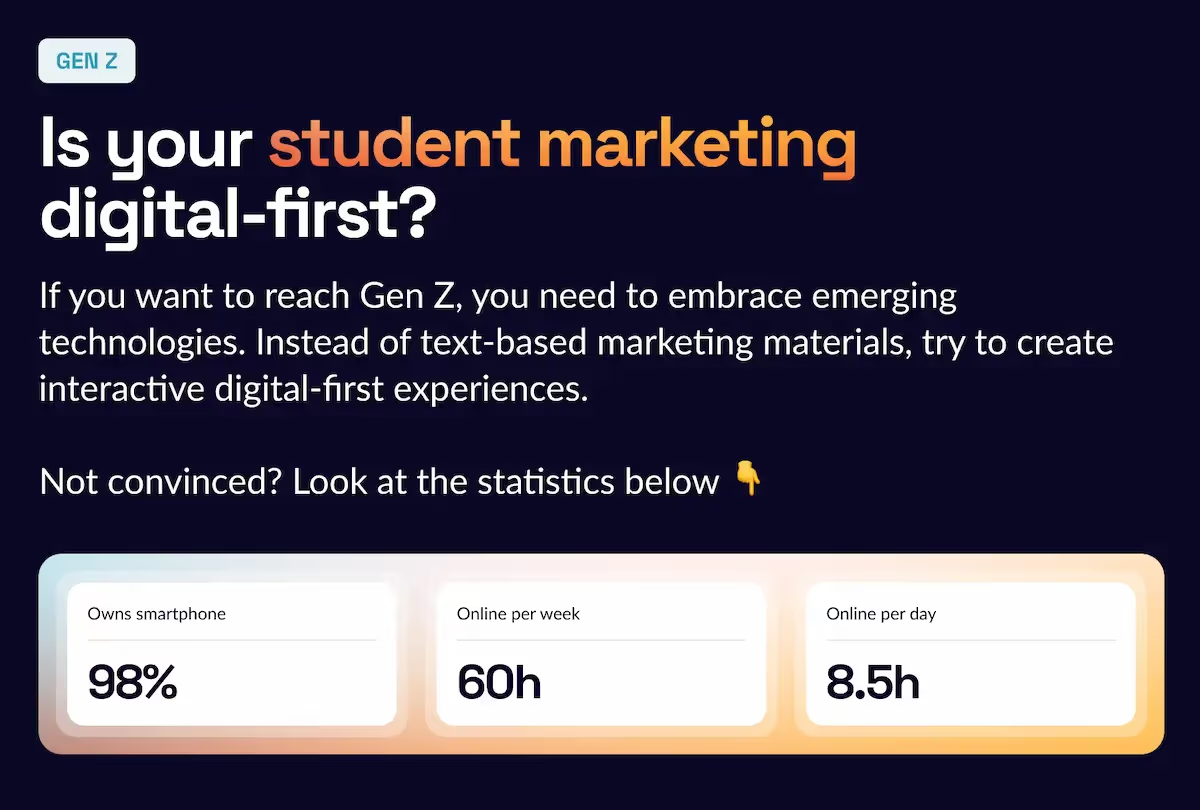
Generations Z and Alpha might sound a bit unusual, almost like terms from a superhero film mixed with ancient Greek tales. However, for those involved in higher education and looking to attract more students, these terms are incredibly important.
Gen Z refers to people born between 1997 and 2012. Right now, they are between 11 and 26 years old. These are the young individuals who are currently studying or will soon be joining your university or college.
The oldest members of Generation Alpha are around 10 years old, right now. Meaning in about six years, they'll begin to seriously think about which university they want to attend.
Our goal is to help you prepare for both current and future student journeys. We've come up with a few strategies to make your university appealing to Gen Z and Alpha students, both today and as we move forward. But first…
What is the student journey, exactly?
The student journey is the entire experience a student goes through from first learning about a university or college to enrolling and graduating. It’s every interaction and experience they have with the institution, including:
- Discovering the university,
- Applying for a course
- Attending classes
- Participating in campus life
This student journey isn’t just about academic learning. It also includes how students:
- Engage with the university community
- Use support services
- Develop personally and professionally
It's a holistic path that shapes their skills, knowledge, and overall university experience. And here’s the fun part: you can make it even better, with the strategies below.
How do you target the student market in general?
If you work in student marketing or university recruitment, you’ve got your job cut out for you. It’s a peculiar target audience you’re trying to attract. Most juvenile generations come with their own peculiar tastes and preferences when it comes to things like:
- What drives them
- Which people they look up to and trust
- What technology they use
- The type of content they consume
- Channels they prefer consuming this content on
First, you need to find out what drives prospective students. Now, you’ll be able to draft messaging that resonates with them. Next, you need to know how to reach them. And finally, you need to put that well-considered messaging in front of them, in the format they prefer.
Marketing to Gen Z & Alpha students: how does it work?
Gen Z and Alpha represent the future demographic of college and university students. As older generations graduate, these younger cohorts will fill the ranks. Understanding their unique characteristics, preferences, and expectations is essential for institutions to remain relevant.
These generations are digital natives, having grown up in a technology-rich environment. They have distinct ways of interacting with technology, consuming content, and communicating.
Adapting to these changes is crucial for higher education institutions to effectively engage with these students. And that doesn’t just go for marketing, but for the actual education itself, as well.

If you’re working in higher education marketing, you first need to ask yourself:
“Is our institution thinking ahead and are we adapting our marketing strategies to these prospective Gen Z and Alpha students?”
If the answer isn’t yes, you might be in trouble. Attracting and retaining students from these generations is key to the long-term success and sustainability of higher education institutions.
To further cement the above, here’s a quote by Marcie Merriman, Cultural Insights & Customer Strategy Leader at EY Americas, from an EY study on Gen Z:
“Generations are born from change. They are a reflection of the society they grew up in, and a framework for understanding how the world is supposed to work. We look at younger generations as a beacon to understanding the future that is coming for all of us. Understanding Gen Z’s wants, needs and aspirations now will help businesses effectively prepare for the shifting human needs and expectations that are already underway.”
Makes sense, right? Anyways, without any further ado, let’s look at our future-focused higher education marketing strategies.
5 college and university marketing strategies for Gen Z and Alpha students
Here are 5 college and university marketing strategies that are designed to help you attract more Gen Z and Alpha students. Implement these, and you’re more likely to keep student applications numbers up now and in the near future.
1. Use advanced digital platforms and technologies
This one’s a given. We already explained how both Gen Z and Alpha generations are set up apart from their predecessors by the fact that they grew up with technology.
First of all, a staggering 98% of Gen Z own a smartphone. On average, they spend up to 60 hours per week online, with an average of 8.5 hours per day.
Generation Alpha are mostly underage, so don’t necessarily own their own smart devices. However, 84% of Gen Alpha in the US currently use technology in their schools.
If you’re not basing your student marketing strategies on these facts, you’re going to lose out to competitors that do. It’s important to make sure your marketing strategies make ample use of augmented reality (AR), virtual reality (VR), and other emerging technologies.
But you also need to realize that traditional, boring videos and long texts aren’t going to grab and hold the attention of these younger generations.
Instead of text-based marketing materials, you need to create interactive experiences that are even more effective if you include elements of gamification. The more engaging the experience, the more memorable your university or college will be.
2. Foster peer interactions
Only 34% of Gen Z believe they can “trust” large organizations or the federal government. They’re more likely to put their faith in individuals and small, localized entities they can actively engage with.

This means your university, as a “large organization”, needs to tread carefully. Peer and community opinions carry way more weight than your educational institute’s corporate communication.
Strategies like ambassador programs where current (Gen Z) students share their experiences work really well.
The next challenge, of course, is digitizing those experiences so they’re in line with the technological expectations of these younger generations. The most ideal situation is where you build a platform that allows younger (Gen Alpha) students to visualize their future in higher education through interactions with older peers.
And how cool if you also include next-gen AR technology like a virtual avatar to really bring that older peer to life. This makes it easier to scale distribution of the experience, too.
3. Personalize and diversify content: make it interactive
Personalizing content is very important for Generation Z and Alpha. Both these groups like messages and content that feel like they are made just for them. This makes them more interested and connected.
At the same time, they also prefer short, quick content. This is because they are used to getting information fast. So, "micro-moments" and "snackable content" are great. Create things that are short and easy to understand. Perfect for their shorter attention spans.
This all culminates in the idea of interactive content. Platforms like Intractive help make content that’s exciting, interactive (obviously), and very much snackable. This makes getting information more fun and engaging for your Gen Z and Alpha audiences. It's like playing a game while learning about your university.
Example: Webster Leiden Campus
Don’t just take our word for it. Check it out yourself. Here’s an interactive experience created with Intractive by Webster, the only American university in the Netherlands. In the experience, they show what makes them unique.

4. Focus on sustainability and social responsibility
Both Gen Z and Alpha are conscious of sustainability and social issues. Granted, Alpha are maybe slightly too young to ascribe fully formed opinions to.
Among the key issues that have commanded the attention of Gen Z are healthcare, mental health, higher education, economic security, civic engagement, race equity, and the environment.
One higher education marketing strategy for your university or college, then, is to showcase institutional initiatives related to sustainability, diversity, and inclusion. If you run these types of initiatives, make sure to show your Gen Z and Alpha audiences.
What’s more, instead of only talking the talk, try walking the walk, as well. Involve current students in community and global projects, as much as possible. Emphasize the real-world impact of these academic programs. This indicates to younger generations that their attendance at your university or college can really make a difference.

5. Prepare for the future: lifelong learning and skill development
The world of higher education itself is also in flux. The advent of the Information Age and the mass adoption of technology puts severe pressure on academic institutions. Basically, every member of Generations Z and Alpha have access to the world’s entire body of information in their pocket.
Information spreads at breakneck speeds, and so do technological developments and requirements of the workforce in general. This also means the lines between traditional education phases are blurring, as a consequence. Rote memorization of information has become a useless skill.
Continuous learning, on the other hand, has become way more important. As part of your higher education marketing strategy, showcase institutional programs that cater to skill development. This proves your university or college can help prepare students for an evolving job market.
Pair this with highlighting partnerships with specific burgeoning industries and tech companies. Show that you’re out to help students stay ahead of the curve.
Implement these strategies to recruit more Gen Z and Alpha students
These are just a few of the student marketing strategies that can help put your university or college on the map of prospective Gen Z and Alpha students. What’s most important is that you take into account the unique preferences and expectations of these younger generations.
We strongly recommend all traditional higher education institutions to take more proactive approaches, to embrace innovation, and remain adaptable in their marketing strategies.
And if you truly want to set yourself apart for younger students. Well. Then you’ll simply need to give the world’s best interactive storytelling platform a spin. Get started with Intractive today, so you can welcome Gen Z and Alpha students next semester.
Ready to change the way you tell stories?
Become and interactive storyteller and immerse your entire audience in your world, today.

"If you want to stand out you can't afford to create boring content. "










